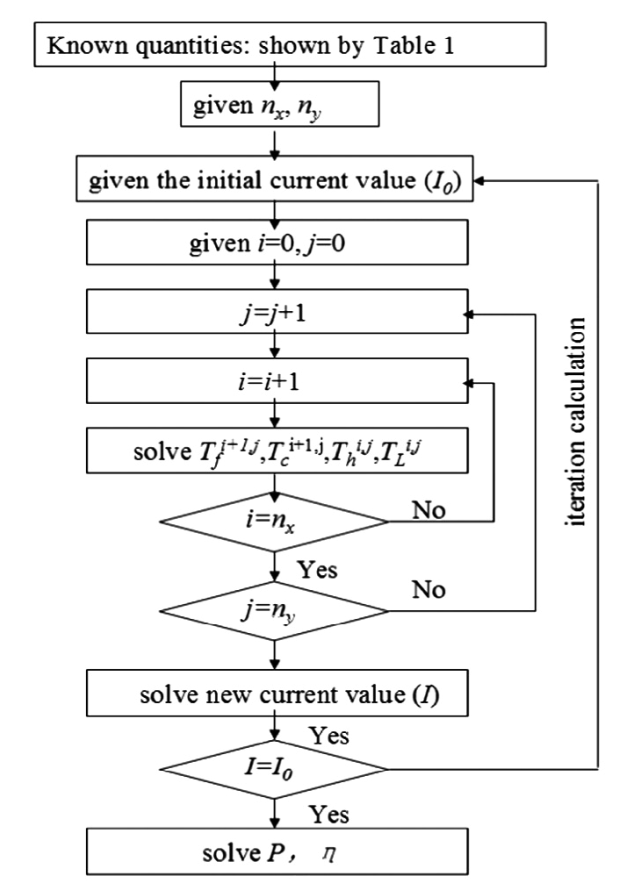We can organize computation in 3 steps. First, we calculate transition matrix tij for every temperature required as follows
Tfav[i, j] = (Tf[i, j] + Tf[i + 1, j])/2;
Tcav[i, j] = (Tc[i, j] + Tc[i + 1, j])/2;
qh1 = cf*mf*(Tf[i, j] - Tf[i + 1, j])/ny;
qh2 = hf*Sf[i, j]*(Tfav[i, j] - Th[i, j]);
qh3 = alphapn*I1*Th[i, j] + Kpn*(Th[i, j] - TL[i, j]) - 0.5*I1^2*Rpn;
qL1 = cc*mc*(Tc[i + 1, j] - Tc[i, j])/ny;
qL2 = hc*Sc[i, j]*(TL[i, j] - Tcav[i, j]);
qL3 = alphapn*I1*TL[i, j] + Kpn*(Th[i, j] - TL[i, j]) + 0.5*I1^2*Rpn;
sol = Solve[{qh1 == qh2, qh2 == qh3, qL1 == qL2,
qL2 == qL3}, {Tf[i + 1, j], Tc[i + 1, j], Th[i, j], TL[i, j]}][[1]]
tij = {Tf[i + 1, j], Tc[i + 1, j], Th[i, j], TL[i, j]} /. sol
On the second step we use tij to compute temperature with I1=0. We don't know how surface areas Sc[i,j], Sf[i,j] can be defined, but in this code its are given constants
alphan = -1.72*10^(-4);
alphap = 2.037*10^(-4);
L = 1.3*10^(-3);
A = 2.08*10^(-6);
kp = 1.265;
kn = 1.011;
sigmap = 1.314 10^-5;
sigman = 1.119 10^-5;
alphapn = alphap - alphan;
Rpn = L/(A)*(sigmap + sigman);
RL = 1;
Kpn = (A/L)*(kp + kn);
cf = 4205;
cc = 4153;
hf = 80;
hc = 1000;
Tfin = 773;
Tcin = 353;
mf = 20;
mc = 200; nx = 20; ny = 10; a = 0.9; b = 0.49;
tf = ConstantArray[Tfin, {nx, ny}];
tc = ConstantArray[Tcin, {nx, ny}]; sf =
ConstantArray[a/nx b/ny, {nx, ny}]; sc = sf;
Do[th[i, j] =
tij[[3]] /. {i -> i, j -> j, Tc[i, j] -> tc[[i, j]],
Tf[i, j] -> tf[[i, j]], Sf[i, j] -> sf[[i, j]],
Sc[i, j] -> sc[[i, j]], I1 -> 0};
tL[i, j] =
tij[[4]] /. {i -> i, j -> j, Tc[i, j] -> tc[[i, j]],
Tf[i, j] -> tf[[i, j]], Sf[i, j] -> sf[[i, j]],
Sc[i, j] -> sc[[i, j]], I1 -> 0};, {i, nx}, {j, ny}]
I0 = Sum[alphapn*(th[i, j] - tL[i, j]), {i, 1, nx}, {j, 1,
ny}]/(nx*ny*Rpn + RL)
Here we have out 7.63885. On the last step we organize iterations up to state where $I$ converges:
ii[0] = I0; Do[
Do[Do[tf[[i + 1, j]] =
tij[[1]] /. {i -> i, j -> j, Tc[i, j] -> tc[[i, j]],
Tf[i, j] -> tf[[i, j]], Sf[i, j] -> sf[[i, j]],
Sc[i, j] -> sc[[i, j]], I1 -> ii[k - 1]};
tc[[i + 1, j]] =
tij[[2]] /. {i -> i, j -> j, Tc[i, j] -> tc[[i, j]],
Tf[i, j] -> tf[[i, j]], Sf[i, j] -> sf[[i, j]],
Sc[i, j] -> sc[[i, j]], I1 -> ii[k - 1]};, {i, 1,
nx - 1}];, {j, ny}];
Do[th[i, j] =
tij[[3]] /. {i -> i, j -> j, Tc[i, j] -> tc[[i, j]],
Tf[i, j] -> tf[[i, j]], Sf[i, j] -> sf[[i, j]],
Sc[i, j] -> sc[[i, j]], I1 -> ii[k - 1]};
tL[i, j] =
tij[[4]] /. {i -> i, j -> j, Tc[i, j] -> tc[[i, j]],
Tf[i, j] -> tf[[i, j]], Sf[i, j] -> sf[[i, j]],
Sc[i, j] -> sc[[i, j]], I1 -> ii[k - 1]};, {i, nx}, {j, ny}];
ii[k] = Sum[
alphapn*(th[i, j] - tL[i, j]), {i, 1, nx}, {j, 1,
ny}]/(nx*ny*Rpn + RL);, {k, 1, 10}]
We can plot $I-I0$ on every step to check convergence
ListLinePlot[Table[ii[k] - I0, {k, 0, 10}], PlotRange -> All]
 Finally we calculate
Finally we calculate
P =
Sum[alphapn*(qh3 - qL3) /. {i -> i, j -> j, Th[i, j] -> th[i, j],
TL[i, j] -> tL[i, j], Sf[i, j] -> sf[[i, j]],
Sc[i, j] -> sc[[i, j]], I1 -> I0}, {i, 1, nx}, {j, 1, ny}];
eta = 100*
P/Sum[qh3 /. {i -> i, j -> j, Th[i, j] -> th[i, j],
TL[i, j] -> tL[i, j], Sf[i, j] -> sf[[i, j]],
Sc[i, j] -> sc[[i, j]], I1 -> I0}, {i, 1, nx}, {j, 1, ny}];
{P, eta}
Out[]= {0.0208876, 0.00331435}



